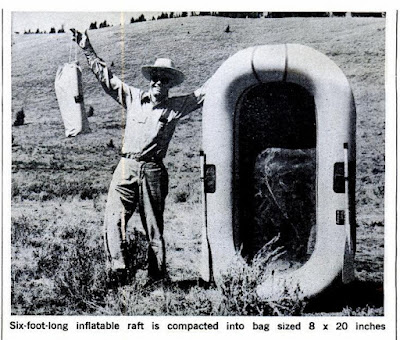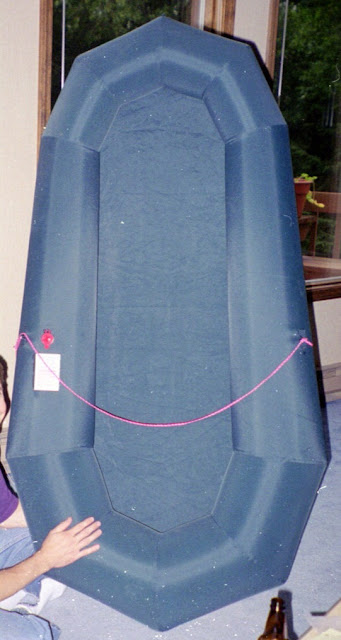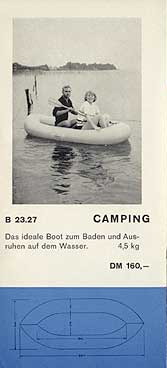This post is part of the History series, a follow up on the previous article about the invention of packrafting.
2. Guys at American Safety Equipment: the naming and commercial attempt (1972), sidelines
As said in the previous article, after Halkett followed
the ‘century gap of packrafting’. There were no means of real portable boats
anymore. Inflatables quickly became large vessels. By 1855 there were already numerous
big types of inflatable rubber boats in use. [13] Only with the raise of
aviation, seafaring and warfare in early 20th century small
inflatables remained available in the form of life rafts for rescue and
survival purposes. However, the idea of hiking with boats as Halkett intended
was lost.
 |
| Packrafting Desperados [14] |
Well, not
quite, there have always been those fellows, who (mis)used military survival and
aviation rescue rafts for exploration and leisure purposed in the way of
packrafting. These were the only small and portable ones available to the time.
People apparently used them for river
crossings, alpine lake floats and real water runs on their trips in the
backcountry. And this
happened all over the world, especially after World War II. All regions have
their legendary uses. The American Dick Griffith Copper Canyon Mexico Franklin Europe has its ‘founding stories’. Lesser
known for example is the first decent of the Goropu canyon in Sardinia in 1969 with the help of small and
portable inflatable boats. [7]
Calling the thing
Next ‘development’ stage was reached in the 1970ies. American Safety Equipment purchased a life raft company (Patten) and tried to commercialize the idea of amphibious travel. Although there was no significant technical development, they did the idea of hiking with boats a favour: they named it. The Term PACKRAFT was officially settled (even copyright registered [2]) as an attempt to distinguish the “ordinary” (read big) inflatable from a backpacking boat.
 |
| Magazins Packraft 'introduction' in 1973 [3] |
There were new material (neoprene,
later urethane coated nylon) in use, but other than that construction remained with
the ‘miniature raft’. American Safety Packrafts were widely advertised and
became a standard of the activity in the 70ies, which stayed a niche though. (Attachment: [16]). However, the concept of boating and walking was re-established first since
Halkett.
 |
| Pack Raft Advertisement in Backpacker 1975 [1a] |
A direct spring off these boats is the legendary Sherpa Packraft in the 80ies, which made the ventures of packrafting pioneers in Alaska
Meandering and variation
As a sideline
in the packraft evolution deemed Curtis Designs rafts. Interestingly, they never
used the term packraft [12] Brian from Curtis Designs says:
 |
| Curtis Designs Raft in 1990 [15] |
“Our design
inspiration came from the surplus rafts we had been using. They had the large
tube on one end that tapered to a smaller tube on the other. My dad did the
design and wrote the code to print the patterns. We stole the idea for an
inflation bag from the bag Stephenson/ Warmlite was using for their down air
mattress. From Jim we were able to learn about heat sealing urethane coated
nylon and got a source for fabric. The prototypes my dad, uncle, and I, built
were beautiful so we decided we had a product we could sell. We sold our first
rafts in 1980. But our
rafts were never intended to be used on rivers. We wanted a raft mostly for
fishing high lakes so light weight was our primary concern, not puncture
resistance. But that isn't to say we never used our rafts in the sense we think
of packrafting today. Most notable was probably a trip in the Gates of the
Arctic NP in 1984 where we rafted down the very mellow Kaluluktok Creek to Walker Lake .“ [10]
The Curtis Boat remains a gold
standard of aesthetic construction [11] Curtis rafts
haven't been made for a number of years, although demand has remained high
thanks to their near legendary reputation among high-lake and backpacking
fishermen.
 |
| Packraft from Germany ? [8] |
Harkening
back to the European way of packrafting (documented with the exploration in
Sardina 1969 for example), there can only be claimed those products in the
sense of Quasi-Packrafts: small, portable boats not named that way, but for
sure used that style:
Silvio
Kunze reports on a conversation with Reinhard Hafermalz from Berolina Wassersport about
ultralight inflatables some 50 years ago. [8] Likewise said Holger Trepte from
his ventures in communist Europe in the 80ies (f. ex. in Bulgaria
East or
West, both systems could not prevent the decade of packraft depression: the
lack of adequate boats in the 90ies (were old ones got pampered), which was
followed by the true reinvention of packrafts in the beginning of 2000:
Sources/References:
[1] American Safety Equipment, Recreation Products Groupe, Advertisement for Pack Raft
a) in
Backpacker 9, Active Interest Media, Inc., 1975, S. 77
b) in
Popular Mechanics, Juli 1972, P.111
 |
| Actual copyright registration for Pack Raft [2] |
[2]
Packraft infl.Boat, Catalog of Copyrights 1973: Copyright Office, The Library
of Congress, Washington 1975, S. 55
[3] New
Nautical Asseeties, M. Paulson, Unknown compact inflatable raft/bath tub
description, Field & Stream, Febr. 1973, P. 144
[4] The
Sherpa Pack Raft, Field & Stream, Jan. 1984, Seite 68
[5] Packraft des Ostens, Kreinacker M., Picasaweb
[6] Bulgarienfahrt 1980, Trepte, H., Telephone interview,
2011
[7] Sardinien 1969, Goropu canyon first decent,
"Reisezeit" in 3sat, 2011
[9] Packrafting!, Dial, Roman, 2008, P. 31, 32
[10] Brian Curtis/Curtis Designs and others, Packraft History Discussion, 2008
[11] Alpacka Raft, About, Packrafting Lore: A Small History of Small Boats
[13] History of inflatable boats on Wikipedia
[14] One-Man Pneumatic Life Raft Survival Kits of World War II, Robert S. McCarter, Douglas Taggart
Schiffer Pub. Ltd., 2006
[15] The Classic Report
[16] Attachment:
 |
| M. Paulson, New Nautical Asseccties, 1973 [3] |










